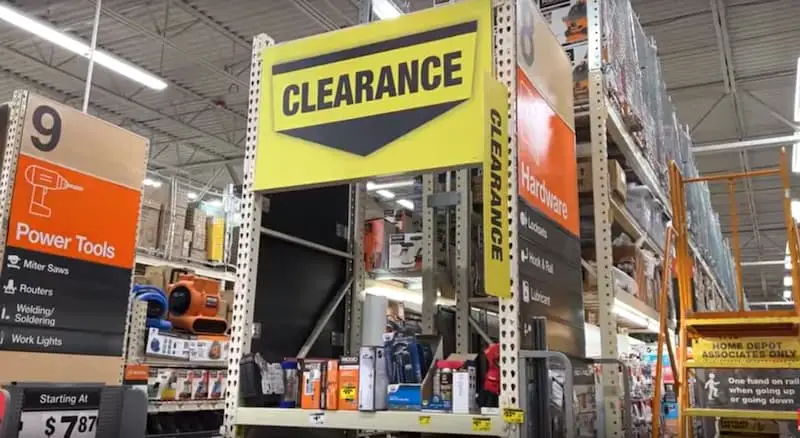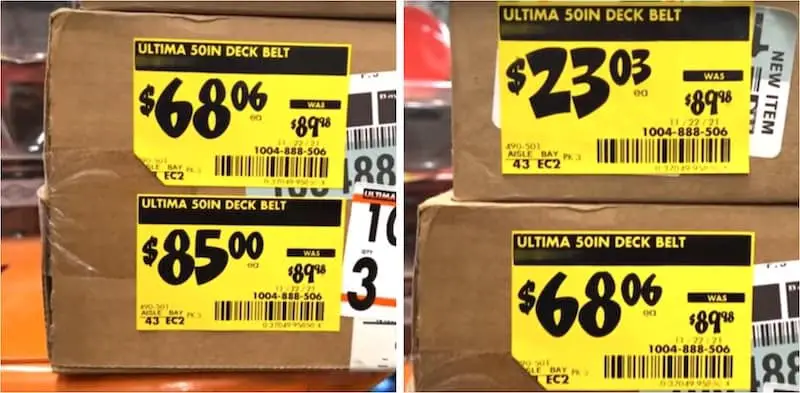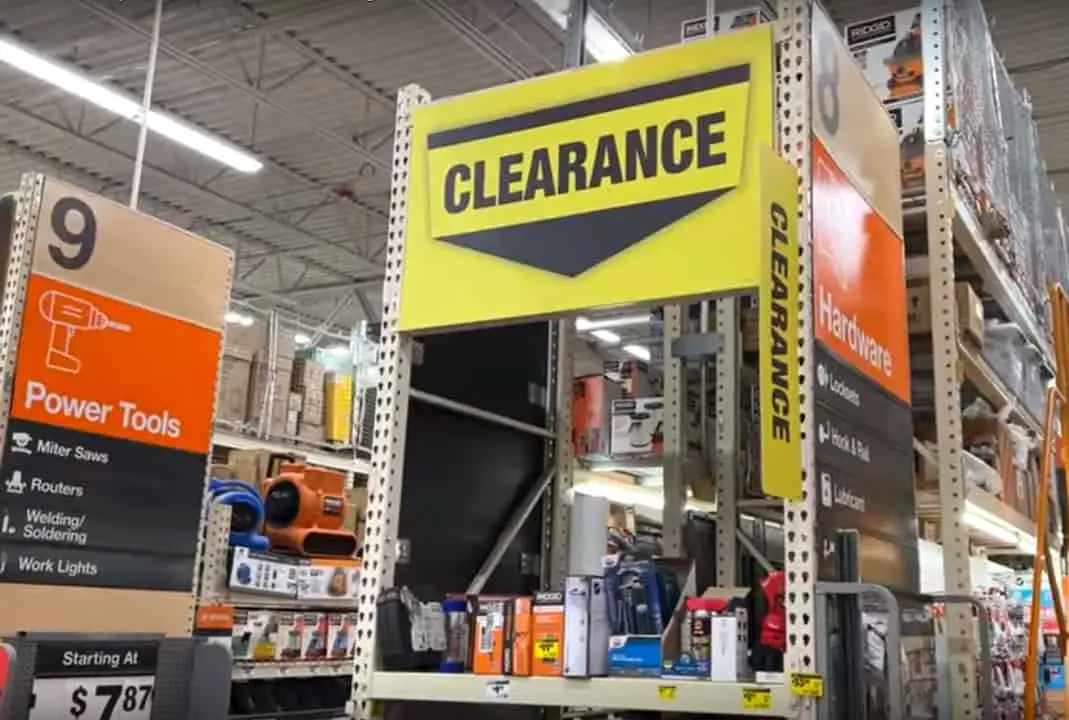The mission of Everyday Home Repairs is to help you save time and money by taking on home repair and maintenance projects yourself.
In this article, we’re focusing on saving money — specifically, how to get great deals on clearance items at Home Depot.
Why Home Depot? Because in a survey of over 4,000 Everyday Home Repairs YouTube viewers, 62% of you who responded said Home Depot was your go-to home improvement store.
Besides its popularity, Home Depot’s clearance pricing has a logical structure that’s pretty easy to decode.
So let’s jump into the secrets of clearance price tags at Home Depot!
How to Get Great Deals on Clearance Items at Home Depot: Step-by-Step Guide
You can tell where the product is in the clearance cycle at Home Depot just by looking at the last two digits of the price. With this wee bit of info, you’ll be able to determine if the product is a great deal now or if it might be better to hold off for a while and see if you can get a better deal.
When I say “a better deal,” sometimes customers get clearance items at Home Depot literally for a penny! We’ve heard from viewers who have bought safety glasses that normally cost around $18 for a penny a pair, $250 worth of corrugated roofing materials for a penny, and (perhaps the best of all time) 20 wooden workbenches originally priced at $200 each for less than a quarter for all 20! It’s not hard to see that these deals could save you hundreds if not thousands of dollars.
So let’s look at where to find these deals! In this guide, I’ll also give you a tangible example of how Home Depot will reduce prices over time, and how much time is in between those price reductions.
At the end of the post, I’ll also share the experiences and comments of some of our YouTube audience that you might find helpful.
Where to Find Clearance Items at Home Depot
Generally, there are two locations for clearance items at Home Depot or other big-box stores.
On End-Caps
The first place to find clearance items is on an end-cap — but not the ones at the front of the store where they have brand-name power tools and other high-profit-margin items. At Home Depot and other big-box stores, you’ll find discounted items on an end-cap in the middle of the store.

As you can see, there’s a whole assortment of items on this typical clearance end-cap.

In addition to the middle of the store, there are clearance areas on the perimeter walls of the store. Think the flooring department and seasonal departments, like lawn and garden. You’ll usually find a collection of end-caps in these locations with products on clearance.
On the Shelves in Departments with High Product Turnover
The other place for clearance items at Home Depot is on the shelves themselves. This is common in departments like Lighting where styles tend to change quickly and there’s a large supply of products.
How to Decode Home Depot Price Tags
Home Depot price tags give you a lot of information with a simple coding structure. When you understand the code, you’ll be able to know what stage of the discount cycle a product is in. Consequently, you’ll know if you’re getting the best deal or not.
You might be surprised at how straightforward it is to decode Home Depot price tags! Better yet, the scheme is also easy to remember.
All summed up, the secret is in the final digits of the price. In other words, the code is in the cents.
First Price Reduction
The first price reduction amounts to Home Depot taking just a little step to move an item. Often these are not very good deals.
Prices in the first round of reductions typically end in 98, 50, or 00.
The discount at this stage might only be somewhere around 10%. Sometimes the price tag doesn’t even show the original price.
To sum things up, Home Depot is just trying to get your attention in this first iteration of clearance pricing by using the yellow price tag and putting the item in the clearance section.
Second Price Reduction
The next iteration of price reductions is when the price ends in 06. In this example, the price is $37.06, so we know that it’s in the second round of price reductions.

When the price ends in 06, the discount is getting better. At this point, the reduction might be 25-50%.
The “06” also indicates that the price will stay put for 6 weeks. That’s a code that’s a cinch to remember, right?
After the 6 weeks of round-two price reductions, we skip into the final round.
Third and Final Price Reduction
When the price ends in 03, we’re in the final phase of Home Depot’s clearance pricing. These are usually great deals. We’re talking about discounts of 75% or even more here because Home Depot is motivated to clear the product from its inventory.
When an item gets to the “03” phase, you guessed it — the item will stay for 3 weeks at that price. After that, it will be designated to be donated or scrapped. And this is where the one-cent price comes in.
What Happens After the Final Three Weeks
If the item isn’t sold within these final three weeks of discounted pricing, it will be removed from Home Depot’s inventory system. It should also be removed from the shelves, but that doesn’t always happen. This is why an item might ring up for one cent when you go through check-out. It exists on the shelf but it doesn’t exist in the system, and the one-cent price is the way it’s handled at the register.
At the end of this article, you’ll find some valuable feedback from our YouTube audience (both customers and former employees of Home Depot) regarding the one-cent phenomenon.
Keep in mind that the date on the clearance tag is the day the item started going through the price-reduction cycle. If you find an item with a price tag that ends with 03 and the date on the tag goes back about 3 months, the article could ring up at a penny. It also could ring up at the “$xx.03” price. You really can’t know whether the item has exceeded the 3-week limit of the final reduction phase until you get to the register.
Here’s an example of the whole price-reduction sequence on the same product, in this case, a deck belt:

- The price was originally $89.98.
- On the first reduction, it goes to $85.
- On the second reduction, it goes to $68.06. It will stay at that price for 6 weeks.
- The final reduction price is $23.03. It will stay at that price for 3 weeks.
When you get to the register, you might pay $23.03 for the product or you might only pay a penny.
The penny items are a bit of a scavenger hunt but they do happen!
How to Get Great Deals on Clearance Items at Home Depot: Tips from Our YouTube Audience
A big shout-out to our YouTube audience for so many great comments on this topic! Here are a few that shed some excellent light on the subject of one-cent deals at Home Depot.
Comment from John Geis: The penny tag is just an indicator to Home Depot associates that the item has passed final markdown. A cashier isn’t supposed to sell you the item for $0.01. They are supposed to get a manager to mark the item back up to that final clearance price. Some cashiers might just override the price to a penny for customer satisfaction, but it’s not a real/valid price. Obviously your experience might differ, but don’t expect to get the penny price, and don’t raise a stink if the cashier does their job and marks the price back up.
Comment from Mark Eckelkamp: Over 20 years ago I worked for Home Depot, my title was “Price Change Auditor.” I did all the changes and replaced the price tags. If I got any items that were to be pulled from the shelves, they would go to $0.01. At that time, I was supposed to pull the items and take them to the back of the store. If I was getting behind on changing prices I was instructed to do those items last. By the end of the week, if I hadn’t finished all my price changes, the managers would just force them all to 1 cent and we would “try” to find them at a later time.
Excerpt of comment from Robert Erickson: Sometimes, when the cashier notices the penny price, they won’t allow you to buy the item. If you call for the store manager and politely demand the penny price with a smile, you will likely get it. My advice is to always avoid the cashier. Use self-check-out when you buy an item that ends in $.03. If you do get a penny deal, don’t start jumping up and down with joy. Once discovered by the cashier or manager, an associate will immediately be sent to remove them from the shelf. Take the item out to your car, then come back into the store for more, if there are any.
Got other home repair projects to tackle?
We’re heading into spring right now, which means I’m going to have some home maintenance items to take care of pretty soon.
You might want to check out our Home Maintenance Checklist article or video, which also includes a link to download the pdf that you can print and hang up.
We’ll catch you on the next project!




